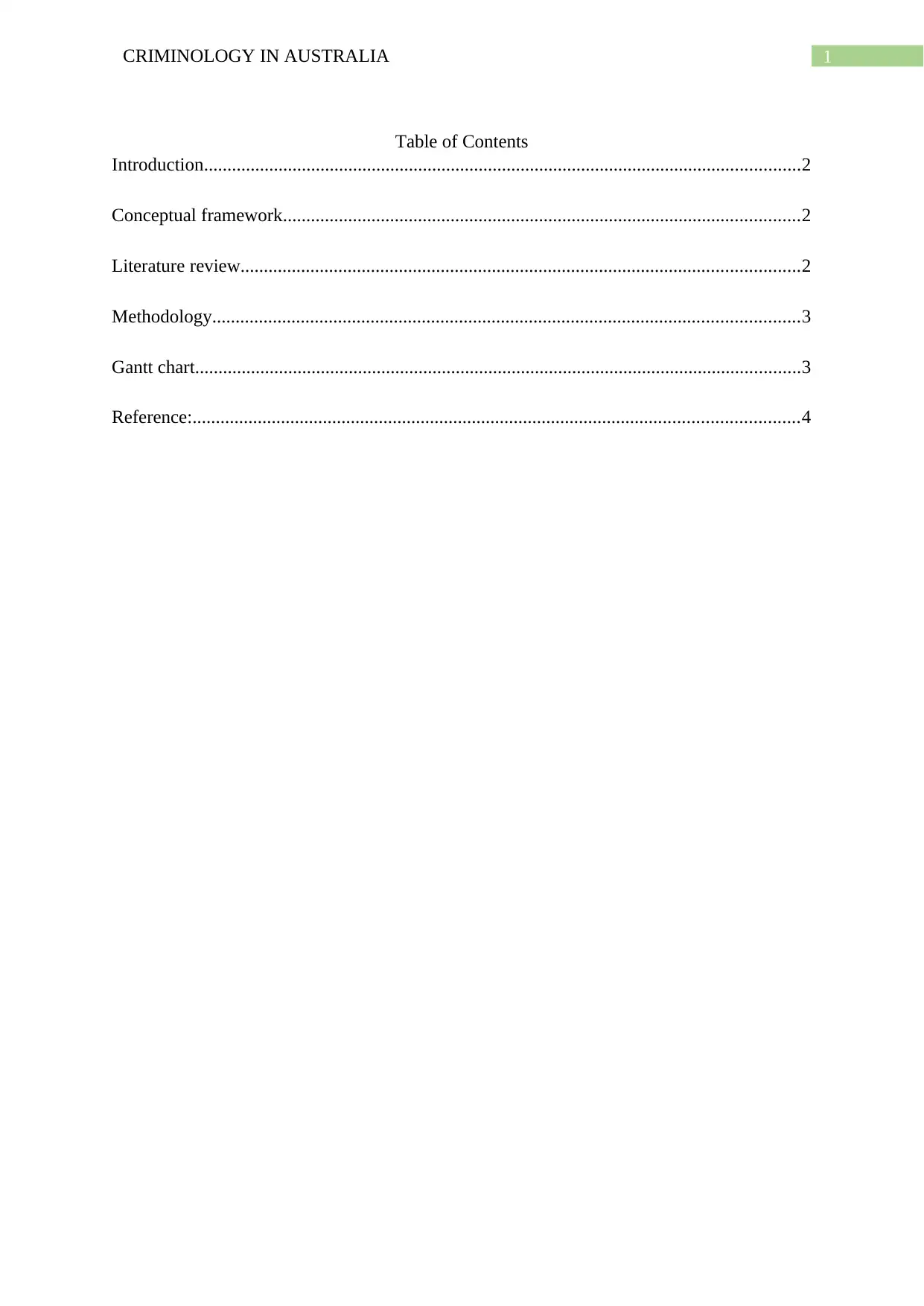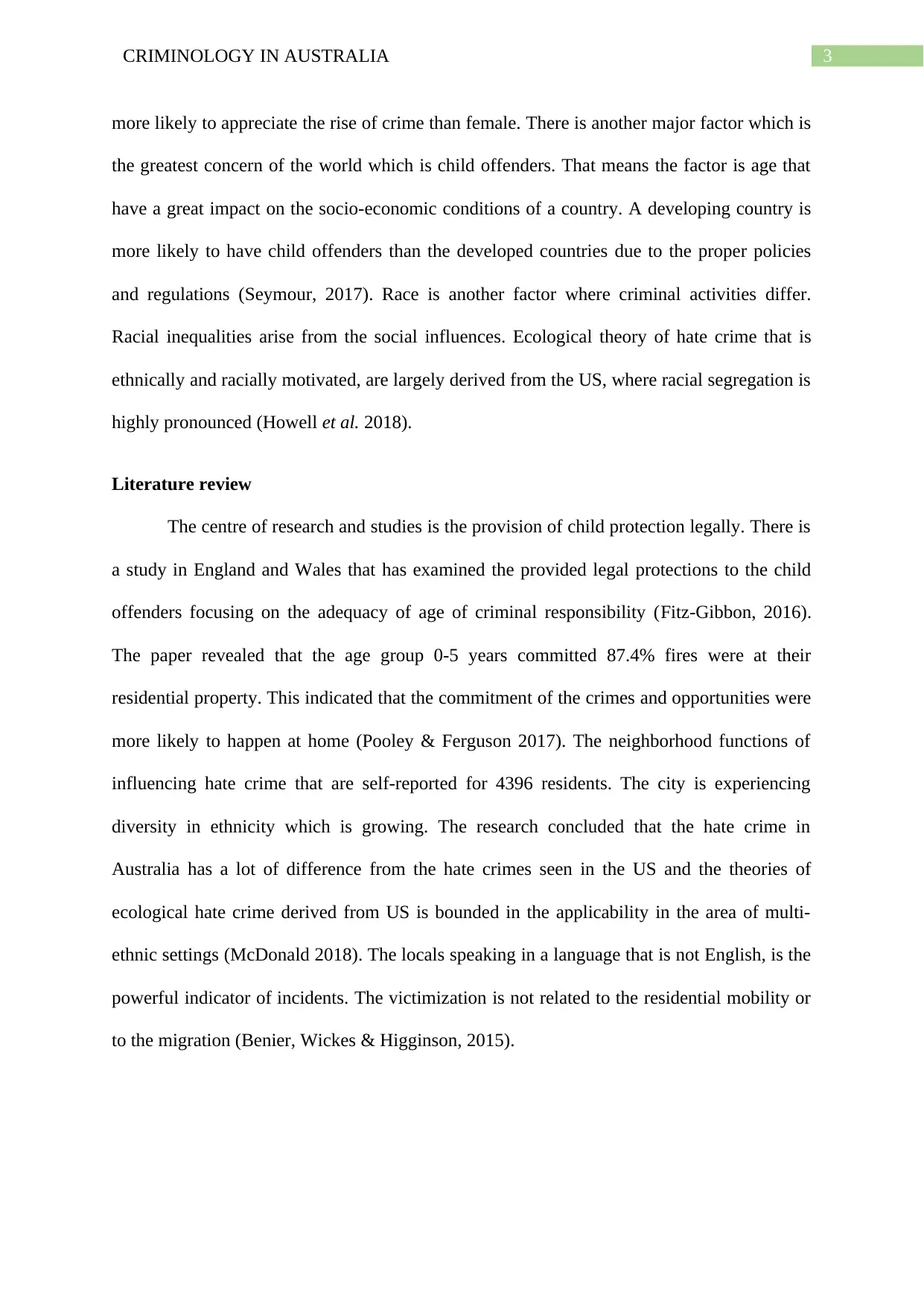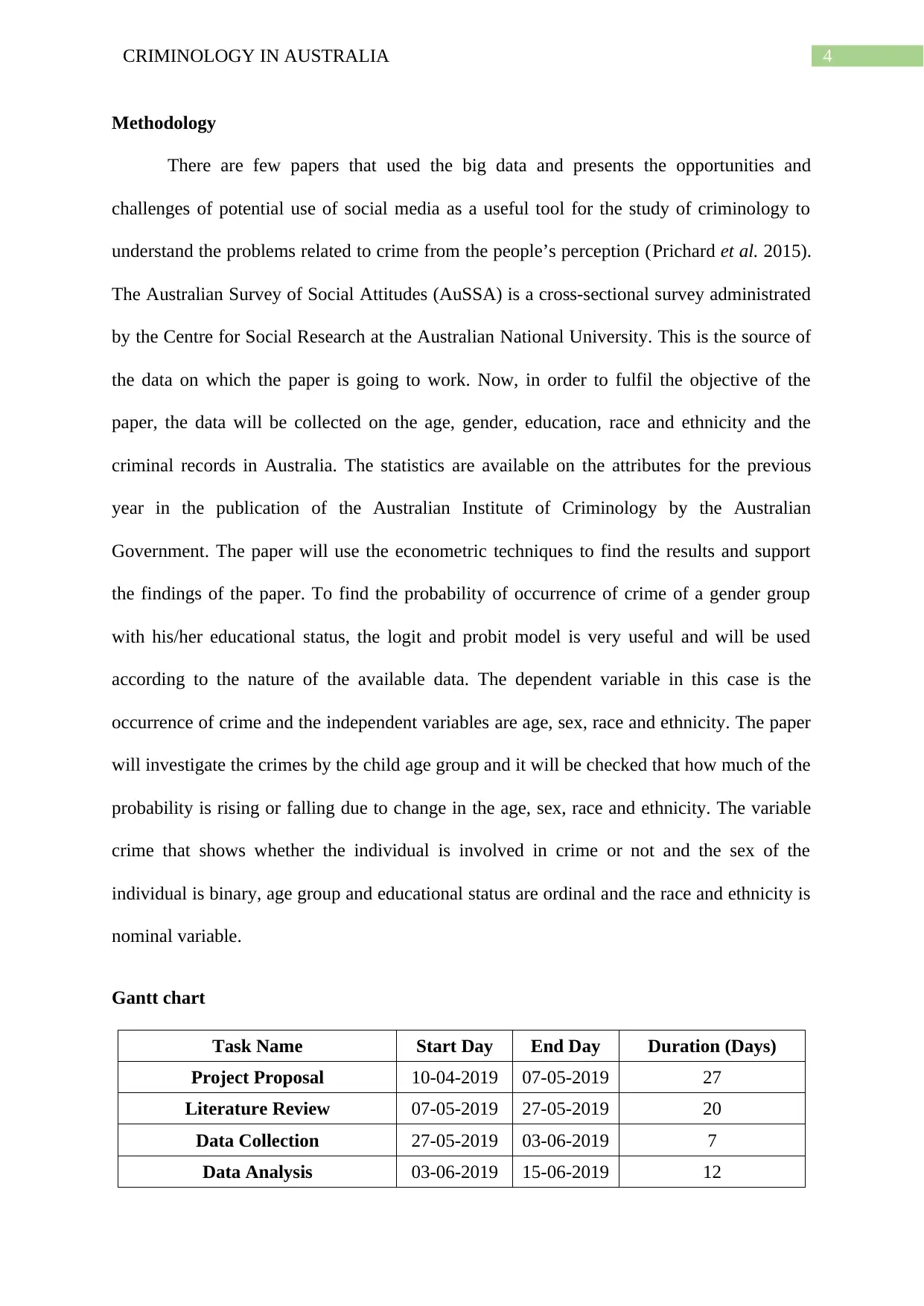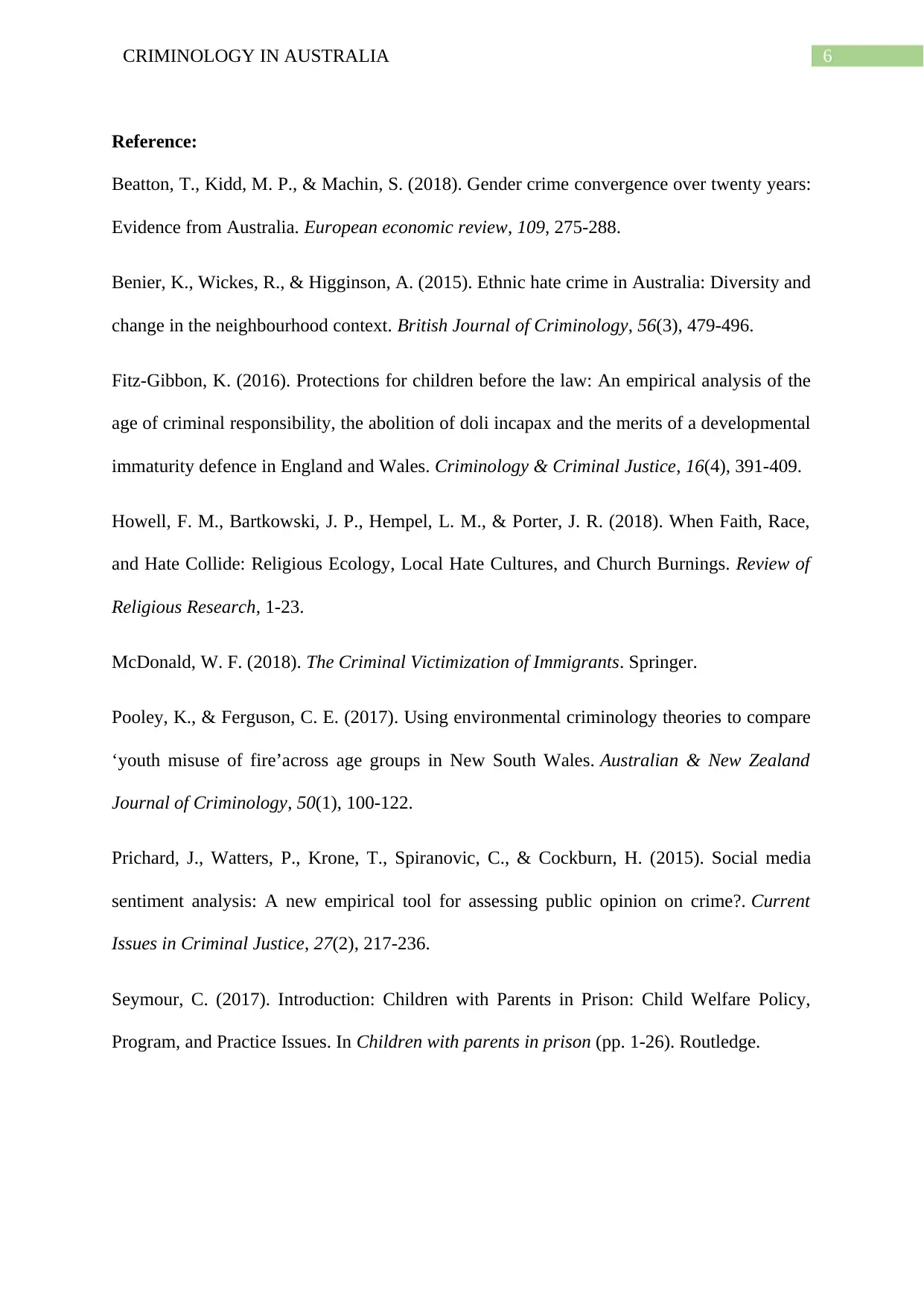3012CCJ - Analyzing Criminology: Social Factors Influencing Crime
VerifiedAdded on 2023/01/04
|7
|1433
|52
Report
AI Summary
This research proposal investigates the influence of social factors on crime in Australia, focusing on gender, education, race, and ethnicity. It aims to determine the involvement of men and women in crimes, considering the impact of education, and to analyze the involvement of children in crime across different racial and ethnic backgrounds. The study utilizes data from the Australian Survey of Social Attitudes (AuSSA) and employs econometric techniques, such as logit and probit models, to analyze the probability of crime occurrence based on these variables. A Gantt chart outlines the project timeline, including literature review, data collection, data analysis, and final report submission. The goal is to provide insights into the socio-economic factors contributing to crime in Australia and to inform policy decisions.

Running head: CRIMINOLOGY IN AUSTRALIA
Criminology in Australia
Name of the Student:
Name of the University:
Author Note:
Criminology in Australia
Name of the Student:
Name of the University:
Author Note:
Paraphrase This Document
Need a fresh take? Get an instant paraphrase of this document with our AI Paraphraser

1CRIMINOLOGY IN AUSTRALIA
Table of Contents
Introduction................................................................................................................................2
Conceptual framework...............................................................................................................2
Literature review........................................................................................................................2
Methodology..............................................................................................................................3
Gantt chart..................................................................................................................................3
Reference:..................................................................................................................................4
Table of Contents
Introduction................................................................................................................................2
Conceptual framework...............................................................................................................2
Literature review........................................................................................................................2
Methodology..............................................................................................................................3
Gantt chart..................................................................................................................................3
Reference:..................................................................................................................................4

2CRIMINOLOGY IN AUSTRALIA
Introduction
The creation of new criminal offences, deciding the scale of penalty and the allocation
of resources for making policies and prosecutions by the policymakers takes an insight look
into the factor that is the concerns of public about the crime victimisation. This concerns are
abler to show the dimensions of the engagement of people in inevitable daily activities and
more often restricting the behaviour. Though, there may exist lack of consistency between
how people realize crime victimization risk and the actual victimization level existing in the
society. The crime across different age group, educational status and the race and ethnicity
have an impact in different levels that change the socio-economic status of a country and
these problems needs to be resolved. The objective of the paper:
1. Investigate the involvement of men and women in crimes. The effect of education in
this context that means is there any significant impact of education on the crime
involvement of men and women.
2. Involvement of child in crime across the race and ethnicity. That means the concern is
that is there any significant evidence that can prove the greater or lower level of
involvement of child from a particular race and ethnicity. One more thing is that the
educational status of that children from that particular race and ethnicity.
Conceptual framework
The crimes in a society can be influenced by the educational qualification, the level of
income and age. However, the criminal activities and the population of prison are majorly
dominated by men around the world (Beatton, Kidd & Machin, 2018). The census data of
2001 and 2016 confirms and reflects that the men criminals has fallen with no fall in women
criminal and the rates of offending in the districts controlled and maintained by the police
services. However, there are some researches that says the crime rate is rising while males are
Introduction
The creation of new criminal offences, deciding the scale of penalty and the allocation
of resources for making policies and prosecutions by the policymakers takes an insight look
into the factor that is the concerns of public about the crime victimisation. This concerns are
abler to show the dimensions of the engagement of people in inevitable daily activities and
more often restricting the behaviour. Though, there may exist lack of consistency between
how people realize crime victimization risk and the actual victimization level existing in the
society. The crime across different age group, educational status and the race and ethnicity
have an impact in different levels that change the socio-economic status of a country and
these problems needs to be resolved. The objective of the paper:
1. Investigate the involvement of men and women in crimes. The effect of education in
this context that means is there any significant impact of education on the crime
involvement of men and women.
2. Involvement of child in crime across the race and ethnicity. That means the concern is
that is there any significant evidence that can prove the greater or lower level of
involvement of child from a particular race and ethnicity. One more thing is that the
educational status of that children from that particular race and ethnicity.
Conceptual framework
The crimes in a society can be influenced by the educational qualification, the level of
income and age. However, the criminal activities and the population of prison are majorly
dominated by men around the world (Beatton, Kidd & Machin, 2018). The census data of
2001 and 2016 confirms and reflects that the men criminals has fallen with no fall in women
criminal and the rates of offending in the districts controlled and maintained by the police
services. However, there are some researches that says the crime rate is rising while males are
⊘ This is a preview!⊘
Do you want full access?
Subscribe today to unlock all pages.

Trusted by 1+ million students worldwide

3CRIMINOLOGY IN AUSTRALIA
more likely to appreciate the rise of crime than female. There is another major factor which is
the greatest concern of the world which is child offenders. That means the factor is age that
have a great impact on the socio-economic conditions of a country. A developing country is
more likely to have child offenders than the developed countries due to the proper policies
and regulations (Seymour, 2017). Race is another factor where criminal activities differ.
Racial inequalities arise from the social influences. Ecological theory of hate crime that is
ethnically and racially motivated, are largely derived from the US, where racial segregation is
highly pronounced (Howell et al. 2018).
Literature review
The centre of research and studies is the provision of child protection legally. There is
a study in England and Wales that has examined the provided legal protections to the child
offenders focusing on the adequacy of age of criminal responsibility (Fitz-Gibbon, 2016).
The paper revealed that the age group 0-5 years committed 87.4% fires were at their
residential property. This indicated that the commitment of the crimes and opportunities were
more likely to happen at home (Pooley & Ferguson 2017). The neighborhood functions of
influencing hate crime that are self-reported for 4396 residents. The city is experiencing
diversity in ethnicity which is growing. The research concluded that the hate crime in
Australia has a lot of difference from the hate crimes seen in the US and the theories of
ecological hate crime derived from US is bounded in the applicability in the area of multi-
ethnic settings (McDonald 2018). The locals speaking in a language that is not English, is the
powerful indicator of incidents. The victimization is not related to the residential mobility or
to the migration (Benier, Wickes & Higginson, 2015).
more likely to appreciate the rise of crime than female. There is another major factor which is
the greatest concern of the world which is child offenders. That means the factor is age that
have a great impact on the socio-economic conditions of a country. A developing country is
more likely to have child offenders than the developed countries due to the proper policies
and regulations (Seymour, 2017). Race is another factor where criminal activities differ.
Racial inequalities arise from the social influences. Ecological theory of hate crime that is
ethnically and racially motivated, are largely derived from the US, where racial segregation is
highly pronounced (Howell et al. 2018).
Literature review
The centre of research and studies is the provision of child protection legally. There is
a study in England and Wales that has examined the provided legal protections to the child
offenders focusing on the adequacy of age of criminal responsibility (Fitz-Gibbon, 2016).
The paper revealed that the age group 0-5 years committed 87.4% fires were at their
residential property. This indicated that the commitment of the crimes and opportunities were
more likely to happen at home (Pooley & Ferguson 2017). The neighborhood functions of
influencing hate crime that are self-reported for 4396 residents. The city is experiencing
diversity in ethnicity which is growing. The research concluded that the hate crime in
Australia has a lot of difference from the hate crimes seen in the US and the theories of
ecological hate crime derived from US is bounded in the applicability in the area of multi-
ethnic settings (McDonald 2018). The locals speaking in a language that is not English, is the
powerful indicator of incidents. The victimization is not related to the residential mobility or
to the migration (Benier, Wickes & Higginson, 2015).
Paraphrase This Document
Need a fresh take? Get an instant paraphrase of this document with our AI Paraphraser

4CRIMINOLOGY IN AUSTRALIA
Methodology
There are few papers that used the big data and presents the opportunities and
challenges of potential use of social media as a useful tool for the study of criminology to
understand the problems related to crime from the people’s perception (Prichard et al. 2015).
The Australian Survey of Social Attitudes (AuSSA) is a cross-sectional survey administrated
by the Centre for Social Research at the Australian National University. This is the source of
the data on which the paper is going to work. Now, in order to fulfil the objective of the
paper, the data will be collected on the age, gender, education, race and ethnicity and the
criminal records in Australia. The statistics are available on the attributes for the previous
year in the publication of the Australian Institute of Criminology by the Australian
Government. The paper will use the econometric techniques to find the results and support
the findings of the paper. To find the probability of occurrence of crime of a gender group
with his/her educational status, the logit and probit model is very useful and will be used
according to the nature of the available data. The dependent variable in this case is the
occurrence of crime and the independent variables are age, sex, race and ethnicity. The paper
will investigate the crimes by the child age group and it will be checked that how much of the
probability is rising or falling due to change in the age, sex, race and ethnicity. The variable
crime that shows whether the individual is involved in crime or not and the sex of the
individual is binary, age group and educational status are ordinal and the race and ethnicity is
nominal variable.
Gantt chart
Task Name Start Day End Day Duration (Days)
Project Proposal 10-04-2019 07-05-2019 27
Literature Review 07-05-2019 27-05-2019 20
Data Collection 27-05-2019 03-06-2019 7
Data Analysis 03-06-2019 15-06-2019 12
Methodology
There are few papers that used the big data and presents the opportunities and
challenges of potential use of social media as a useful tool for the study of criminology to
understand the problems related to crime from the people’s perception (Prichard et al. 2015).
The Australian Survey of Social Attitudes (AuSSA) is a cross-sectional survey administrated
by the Centre for Social Research at the Australian National University. This is the source of
the data on which the paper is going to work. Now, in order to fulfil the objective of the
paper, the data will be collected on the age, gender, education, race and ethnicity and the
criminal records in Australia. The statistics are available on the attributes for the previous
year in the publication of the Australian Institute of Criminology by the Australian
Government. The paper will use the econometric techniques to find the results and support
the findings of the paper. To find the probability of occurrence of crime of a gender group
with his/her educational status, the logit and probit model is very useful and will be used
according to the nature of the available data. The dependent variable in this case is the
occurrence of crime and the independent variables are age, sex, race and ethnicity. The paper
will investigate the crimes by the child age group and it will be checked that how much of the
probability is rising or falling due to change in the age, sex, race and ethnicity. The variable
crime that shows whether the individual is involved in crime or not and the sex of the
individual is binary, age group and educational status are ordinal and the race and ethnicity is
nominal variable.
Gantt chart
Task Name Start Day End Day Duration (Days)
Project Proposal 10-04-2019 07-05-2019 27
Literature Review 07-05-2019 27-05-2019 20
Data Collection 27-05-2019 03-06-2019 7
Data Analysis 03-06-2019 15-06-2019 12

5CRIMINOLOGY IN AUSTRALIA
Final Report Submission 15-06-2019 11-07-2019 26
.
Final Report Submission 15-06-2019 11-07-2019 26
.
⊘ This is a preview!⊘
Do you want full access?
Subscribe today to unlock all pages.

Trusted by 1+ million students worldwide

6CRIMINOLOGY IN AUSTRALIA
Reference:
Beatton, T., Kidd, M. P., & Machin, S. (2018). Gender crime convergence over twenty years:
Evidence from Australia. European economic review, 109, 275-288.
Benier, K., Wickes, R., & Higginson, A. (2015). Ethnic hate crime in Australia: Diversity and
change in the neighbourhood context. British Journal of Criminology, 56(3), 479-496.
Fitz-Gibbon, K. (2016). Protections for children before the law: An empirical analysis of the
age of criminal responsibility, the abolition of doli incapax and the merits of a developmental
immaturity defence in England and Wales. Criminology & Criminal Justice, 16(4), 391-409.
Howell, F. M., Bartkowski, J. P., Hempel, L. M., & Porter, J. R. (2018). When Faith, Race,
and Hate Collide: Religious Ecology, Local Hate Cultures, and Church Burnings. Review of
Religious Research, 1-23.
McDonald, W. F. (2018). The Criminal Victimization of Immigrants. Springer.
Pooley, K., & Ferguson, C. E. (2017). Using environmental criminology theories to compare
‘youth misuse of fire’across age groups in New South Wales. Australian & New Zealand
Journal of Criminology, 50(1), 100-122.
Prichard, J., Watters, P., Krone, T., Spiranovic, C., & Cockburn, H. (2015). Social media
sentiment analysis: A new empirical tool for assessing public opinion on crime?. Current
Issues in Criminal Justice, 27(2), 217-236.
Seymour, C. (2017). Introduction: Children with Parents in Prison: Child Welfare Policy,
Program, and Practice Issues. In Children with parents in prison (pp. 1-26). Routledge.
Reference:
Beatton, T., Kidd, M. P., & Machin, S. (2018). Gender crime convergence over twenty years:
Evidence from Australia. European economic review, 109, 275-288.
Benier, K., Wickes, R., & Higginson, A. (2015). Ethnic hate crime in Australia: Diversity and
change in the neighbourhood context. British Journal of Criminology, 56(3), 479-496.
Fitz-Gibbon, K. (2016). Protections for children before the law: An empirical analysis of the
age of criminal responsibility, the abolition of doli incapax and the merits of a developmental
immaturity defence in England and Wales. Criminology & Criminal Justice, 16(4), 391-409.
Howell, F. M., Bartkowski, J. P., Hempel, L. M., & Porter, J. R. (2018). When Faith, Race,
and Hate Collide: Religious Ecology, Local Hate Cultures, and Church Burnings. Review of
Religious Research, 1-23.
McDonald, W. F. (2018). The Criminal Victimization of Immigrants. Springer.
Pooley, K., & Ferguson, C. E. (2017). Using environmental criminology theories to compare
‘youth misuse of fire’across age groups in New South Wales. Australian & New Zealand
Journal of Criminology, 50(1), 100-122.
Prichard, J., Watters, P., Krone, T., Spiranovic, C., & Cockburn, H. (2015). Social media
sentiment analysis: A new empirical tool for assessing public opinion on crime?. Current
Issues in Criminal Justice, 27(2), 217-236.
Seymour, C. (2017). Introduction: Children with Parents in Prison: Child Welfare Policy,
Program, and Practice Issues. In Children with parents in prison (pp. 1-26). Routledge.
1 out of 7
Related Documents
Your All-in-One AI-Powered Toolkit for Academic Success.
+13062052269
info@desklib.com
Available 24*7 on WhatsApp / Email
![[object Object]](/_next/static/media/star-bottom.7253800d.svg)
Unlock your academic potential
Copyright © 2020–2025 A2Z Services. All Rights Reserved. Developed and managed by ZUCOL.





